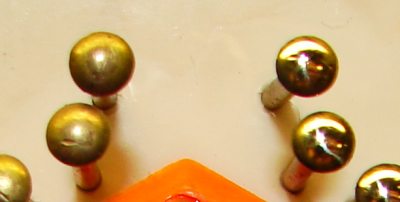To clean most of the plastic on the machine the glass cleaner works ok. For harder stains, I would use a product like Gel-Gloss - (They also give out free samples!). Gel-Gloss worked GREAT on all the surfaces from the chrome to the playing field, and the outer case! You can get it either in a liquid, or spray form. I like the spray form as I can spray some on a rag, or a Q-Tip. It also coats the surfaces with a light wax sealing out moisture.
Gel-Gloss removed all the rust from the chrome surfaces, and left them super clean and shiny! IT also removed the "gunk" from the playing surface. Be warned expect to spend HOURS cleaning an old machine and at least 200 Q-Tips! Basically it was the only stuff I used. You can find it at Home Depot, and some marine stores.
On my "new" machine found that Blue Magic (right) works very well on almost all the surfaces of the machine to remove tarnish, rust, and even spray paint over spray from plastic parts! Other car finish products work well too. Turtle Wax spray detailer worked well on the playing surface, this along with a toothbrush really cleaned up some of the finer details on the game board.
Avoid use of a Dremel Moto-Tool with a felt tip, or any type of high speed polisher. I did this in a few spots and it either damaged (melted) plastic due to friction, or was just too strong for the chrome, and left a "swirl" type of pattern!
However, the polisher DOES work very well on cleaning the brass pins (the heads of them).
Place a very thin layer to Blue Magic onto the heads. Wait 1 min. Wipe them off (if you see any "blue paste" you left too much! Then buff with a Dremel on low speed. Beware this will make some "fuzz" on the playing board and it must be cleaned off after buffing. Here is a close up shot.. No need to say which side is cleaner. :)

As for the rear of the machine DON'T USE WD-40! WD-40 tends to attract dust like you can't believe, plus I don't like the spray - it's just too damn messy and stinks! Dura-Lube makes a nice synthetic oil (while I think their claims for auto products are crap.) in a small spray bottle that does not get messy when used. Slick-50 also made a similar product (and again, I would never add anything to my car from them.) See the "about me page" for the reason why…
Hobby shops also sell "plastic oil" that is safe for plastics and lubes metal nicely without attracting tons of dust. Graphite and precession Teflon oilier also work really well, as do sewing machine oilier and so on.
If the machine moves ok, you may choose not to oil it. However if any of the linkages stick, squeak, or bind, lube them. Feel free to remove plastic covers for service and cleaning. Anything that is held on with a nail or staple can be removed with a pair of "dykes" or needle nose pliers. Replace the nails with any type of screw that has the same length and size. I found a set of assorted "low grade" hardware at a local dollar store. The screws I got must have been old pachinko machine screws - because they fit PERFECT and had the same "cheap aged" look as the rest of the screws!
If you take the machine apart have a clean open work surface, with a few small trays to add screws and small hardware. A digital camera or Polaroid may be nice.
Areas that really need to be kept clean are the Winning Ball Tray (1), and the Winning Ball Exit/Playing Tray (D). This is where dust tends to settle and then get on the balls, and then into the machine. Wipe it out as needed.
If the balls get rusty or pitted badly - trash them. If the balls get dirty, you CAN clean them, I found that a few rags, 20 balls at a time, and spray Brake Clean (for car brakes) works great. So wear gloves! However, it evaporates very quickly and leaves no residue.
WARNING! Brake Clean is very flammable and toxic! It must be used in a well-ventilated area! It is also VERY BAD FOR PLASTIC! DO NOT GET IT ANYWHERE NEAR THE MACHINE!
Lay the balls under a few rags, spray them, then place another rag on top and roll/smush them around. They will shine right up and leave the dirt on the rags! Let them dry before putting them back into the machine.
Glass cleaner/Glass Plus Wipes work very well., #2 Phillips screw driver, pliers, dental pick set, needle nose pliers, Gel-Gloss, Q-tips, lots of clean soft cotton rags, light grade sand paper, mag wheel polish, plastic or synthetic oil, lint free Micro fiber towels, old toothbrushes.
Paint Pens (Hobby Store), and Sharpie markers make great little detail touch ups for worn or damaged graphics, paint, or trim!

Blue Magic works FANTASTIC on plastic, chrome, and the brass pins..
Things NOT TO USE;
"Gummout" type cleaners, alcohol-based cleaners, or caustic cleaners (these will damage plastics) WD 40 Attracts Dust, and High Speed Polishers melt plastics and "swirl" metals.
copyright (C) Dan Reed